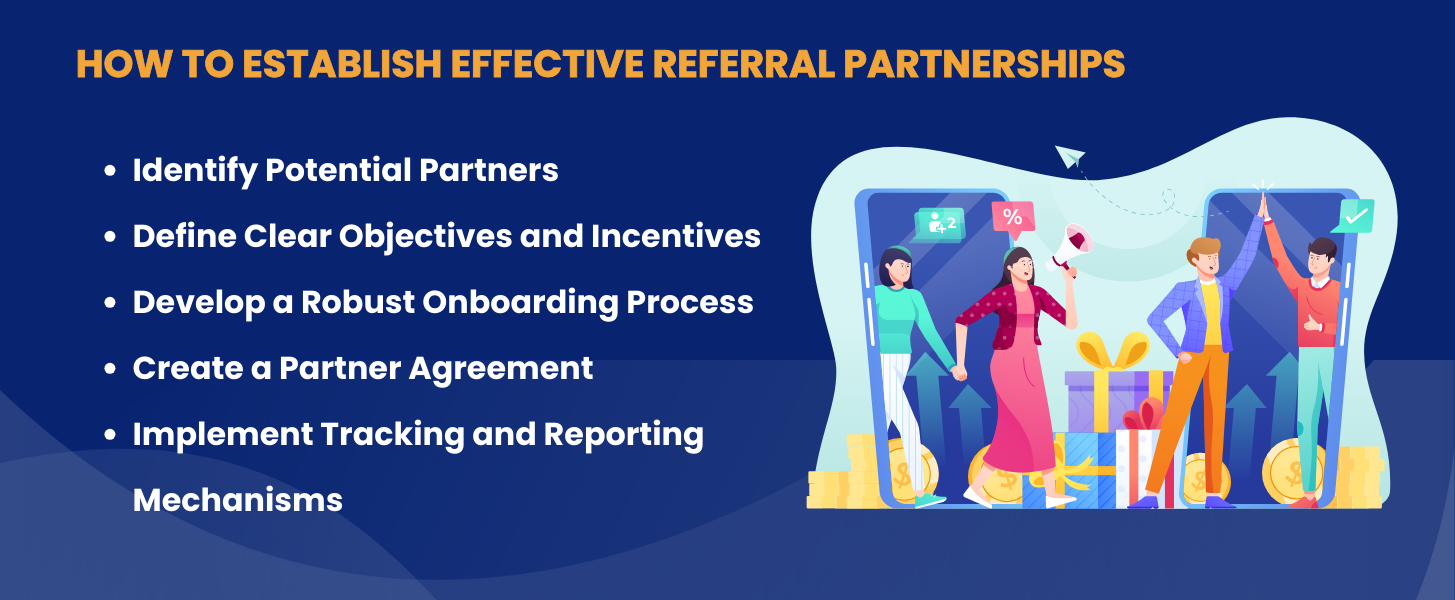In the modern business landscape, partnerships have become a cornerstone for growth and sustainability. Among various types of partnerships, referral partner marketing stands out as a highly effective strategy for businesses looking to expand their reach and drive sales. This comprehensive blog explores the nuances of building a robust partner ecosystem through effective referral partner marketing.
Understanding Referral Partnerships
A referral partnership is a business arrangement where a company collaborates with partners to refer customers to its products or services. These partnerships can also be formalized as customer referral programs, where referral partners or affiliates receive incentives, such as commissions or bonuses, for successful referrals. This model leverages the existing networks and credibility of partners to attract new customers, thereby creating a win-win situation for both parties.
Importance of Referral Partnerships in Modern Business
In today’s competitive market, businesses are continually seeking innovative ways to attract and retain customers. Customer referrals play a crucial role in the effectiveness of referral partnerships. Referral partnerships are invaluable because they offer a cost-effective method to acquire new customers while enhancing brand credibility. By tapping into the trust and networks of referral partners, businesses can reach wider audiences and gain a competitive edge.
Benefits of Referral Partnerships
Referral partnerships offer numerous benefits, making them a vital component of a comprehensive marketing strategy. Some key advantages include:
1.Cost-Effective Customer Acquisition
Referral marketing significantly reduces customer acquisition costs compared to traditional advertising. Since partners are only compensated for successful referrals, businesses can better manage their marketing budgets, directing funds to where they are most effective.
2. Enhanced Credibility and Trust
Customers are more likely to trust recommendations from known and trusted sources. Referral partnerships leverage this trust, leading to higher conversion rates. When a referral comes from a trusted source, potential customers feel more confident in their decision to engage with the brand.
3.Expanded Market Reach
By collaborating with partners across different regions and industries, businesses can penetrate new markets and reach diverse customer segments. This expanded reach can be particularly beneficial for companies looking to grow their customer base beyond their immediate geographic location.
4.Scalability
Referral partnerships are highly scalable. As the number of partners grows, so does the potential for customer acquisition, without a proportional increase in costs. This scalability makes referral marketing an attractive option for businesses of all sizes, from startups to large enterprises.
5.Improved Customer Retention
Referred customers often have higher retention rates because they come with a built-in sense of trust and loyalty. When customers are referred by someone they trust, they are more likely to remain loyal to the brand, leading to increased customer lifetime value.

How to Establish Effective Referral Partnerships
Building referral partnerships requires a strategic approach. Here are the steps to create a successful referral partner program:
1.Identify Potential Partners
The first step is to identify potential partners who align with your business goals and target audience. Look for partners who:
- Have a complementary product or service
- Share similar customer demographics
- Possess a strong reputation and network
Research potential partners thoroughly to ensure they are a good fit for your business and can bring value to your referral program.
2.Define Clear Objectives and Incentives
Clearly define the goals of your referral partnership program. Determine what success looks like and establish metrics to measure performance. Additionally, create attractive incentive structures to motivate partners. Common incentives include:
- Commission-based payments
- Performance bonuses
- Discounts or free products
Ensure that the incentives are appealing enough to motivate partners to actively participate and refer high-quality leads.
3.Develop a Robust Onboarding Process
A seamless onboarding process is crucial for setting partners up for success. Provide comprehensive training and resources, including:
- Detailed product information
- Marketing materials
- Step-by-step guides on the referral process
An effective onboarding process ensures that partners have all the information they need to promote your products or services confidently and effectively.
4.Create a Partner Agreement
Draft a formal referral partner marketing agreement that outlines the terms and conditions of the partnership. Include details on:
- Commission rates and payment schedules
- Responsibilities and expectations
- Confidentiality and non-compete clauses
A clear and comprehensive partner agreement helps prevent misunderstandings and ensures that both parties are aligned in their expectations.
5.Implement Tracking and Reporting Mechanisms
To ensure transparency and measure performance, implement robust tracking and reporting mechanisms. Use referral tracking software to monitor referrals and conversions accurately. This allows you to track the effectiveness of your referral program and make data-driven decisions to optimize its performance.
Managing and Nurturing a Successful Referral Partnership
Once successful referral partnerships are established, ongoing management and nurturing are essential for sustained success. Here are some best practices:
1.Maintain Regular Communication
Regular communication is vital to keep partners engaged and informed. Use various communication channels, such as:
- Email newsletters
- Webinars
- Social media groups
Consistent communication helps keep partners updated on new products, promotions, and changes to the referral program, ensuring they remain motivated and engaged.
2.Provide Continuous Training and Support
Offer ongoing training and support to help partners stay updated on product changes and marketing strategies. Provide access to:
- Updated marketing materials
- Product training sessions
- Dedicated support teams
Continuous training and support ensure that partners have the knowledge and resources they need to succeed, leading to better referral outcomes.
3.Recognize and Reward Top Performers
Acknowledging and rewarding top-performing partners fosters a sense of appreciation and motivation. Consider implementing:
- Recognition programs
- Performance-based bonuses
- Public acknowledgments in newsletters or events
Recognizing and rewarding partners for their efforts can boost morale and encourage them to continue driving high-quality referrals.
4.Gather and Act on Feedback
Solicit feedback from partners regularly to understand their challenges and areas for improvement. Use this feedback to enhance your referral program and address any concerns promptly. Acting on partner feedback shows that you value their input and are committed to their success.
Tools and Technologies for Referral Partnerships
Leveraging the right tools and technologies can streamline referral partner marketing and enhance its effectiveness. Some essential tools include:
1.Referral Tracking Software
Referral tracking software helps monitor and manage referrals, ensuring accurate tracking of partner activities and performance. Look for features such as:
- Real-time tracking
- Detailed reporting
- Easy integration with other systems
2.Customer Relationship Management (CRM) Systems
Integrating CRM systems with referral programs allows for better management of partner relationships and customer interactions. Key features to consider include:
- Contact management
- Sales pipeline tracking
- Automated follow-ups
3.Marketing Automation Tools
Marketing automation tools help in creating and distributing marketing materials to partners, as well as tracking campaign performance. Useful features include:
- Email marketing
- Social media management
- Analytics and reporting
4.Analytics Platforms
Analytics platforms provide insights into referral program performance, enabling data-driven decisions. Important features include:
- Customizable dashboards
- Advanced reporting
- Predictive analytics
Using these tools, businesses can gain a deeper understanding of their referral programs and make informed decisions to optimize performance.
Best Practices for Referral Partnerships
To maximize the effectiveness of your referral partnerships, adhere to the following best practices:
1.Align with Strategic Goals
Ensure that your referral partnership program aligns with your overall business strategy. Define clear objectives and align partner activities with these goals. This alignment ensures that the referral program contributes to the broader business objectives.
2.Foster Transparency and Trust
Build a foundation of transparency and trust with your partners. Clearly communicate expectations, provide regular updates, and honor commitments. Transparency and trust are crucial for maintaining strong and long-lasting partnerships.
3.Focus on Partner Enablement
Empower your partners with the tools, resources, and support they need to succeed. Invest in their growth and development. Partner enablement involves providing comprehensive training, marketing materials, and ongoing support to help partners effectively promote your products or services.
4.Measure and Optimize Performance
Continuously measure the performance of your referral program using key metrics such as:
- Referral volume
- Conversion rates
- Customer lifetime value
Use this data to identify areas for improvement and optimize your program accordingly. Regularly reviewing and optimizing your referral program ensures that it remains effective and continues to drive high-quality referrals.

Challenges in Referral Partnerships
Despite their numerous benefits, referral partnerships come with their own set of challenges, such as reaching out to and pitching to potential referral partners. Common obstacles include:
1.Partner Engagement
Keeping partners consistently engaged and motivated can be challenging. Address this by:
- Offering competitive incentives
- Providing regular training and support
- Recognizing and rewarding achievements
2.Tracking and Attribution
Accurately tracking referrals and attributing conversions to the right partners can be complex. Implement robust tracking systems and regularly audit them for accuracy. Ensuring accurate tracking and attribution is crucial for maintaining trust and transparency with partners.
3.Maintaining Consistent Quality
Ensuring that partners maintain the quality of referrals is crucial. Establish clear guidelines and provide ongoing support to uphold standards. Regularly reviewing and providing feedback on partner performance can help maintain the quality of referrals.
4.Managing Partner Expectations
Aligning partner expectations with your business goals can be difficult. Communicate openly and regularly to manage expectations effectively. Clear and consistent communication helps ensure that both parties are aligned and working towards common goals.
Future Trends in Referral Partnerships
The landscape of referral partnerships is continually evolving, with the future potential of successful referral partnerships becoming increasingly apparent. Here are some future trends to watch:
1.Increased Use of AI and Automation
Artificial intelligence and automation are set to play a significant role in referral marketing. AI can help in identifying high-potential partners, personalizing communications, and optimizing performance. Automation can streamline processes, making it easier to manage and scale referral programs.
2.Greater Emphasis on Data-Driven Decisions
As data analytics becomes more sophisticated, businesses will increasingly rely on data-driven decisions to refine their referral programs and improve outcomes. Advanced analytics can provide deeper insights into partner performance and customer behavior, enabling more effective program optimization.
3.Expansion of Global Partnerships
With the rise of digital platforms, businesses can easily form referral partnerships across borders, expanding their reach and tapping into new markets. Global partnerships can provide access to new customer segments and drive significant growth.
4.Enhanced Partner Experience
Improving the partner experience will become a priority. Businesses will focus on providing seamless onboarding, comprehensive support, and engaging incentives to attract and retain top partners. Enhancing the partner experience can lead to more productive and motivated partners, driving better referral outcomes.
5.Integration with Other Marketing Channels
Referral marketing will increasingly integrate with other marketing channels, such as social media, content marketing, and influencer marketing, to create a holistic and cohesive strategy. Integrated marketing efforts can amplify the impact of referral programs and reach a broader audience.
Building a robust partner ecosystem through effective referral partner marketing is a powerful strategy for business growth. By understanding the intricacies of referral partnerships, leveraging the right tools and technologies, and adhering to best practices, businesses can unlock new opportunities and drive sustained success. As the landscape continues to evolve, staying ahead of trends and continuously optimizing your referral program will ensure long-term benefits and a competitive edge in the market.